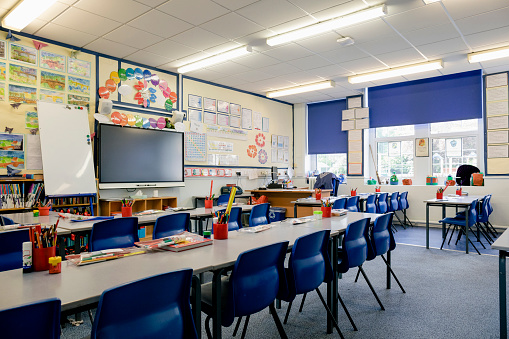Is bigger better? The difference between small and large schools

A wide angle view of an organised and tidy classroom in a school in Hexham in the North East of England
March 8, 2023
It’s no secret that at CHS, everyone knows everyone and pretty much everything about everyone. Rumors spread like wildfire and as a new student, I stuck out like a sore thumb when I transferred at the beginning of this semester.
Coming from a sophomore class of nearly a thousand, twice as much as the entirety of my new school, it was a huge change for me.
Social aspect:
As soon as I walked in on my first day, all eyes turned towards me. A week later, everyone knew me as the Noblesville girl, even people I had not met yet. At my old school, a new student would be unnoticeable, as it’s impossible to know everyone at a school of 3,600 people to begin with, and I was still seeing new faces after attending the high school for a year and a half.
Being in a school that big was tough, because everyone stuck with who they already knew, and this formed cliques and a divided school. At CHS, everyone is a family and I already feel like I am becoming a part of it.
At my old school, the overcrowded halls made passing periods insufferable with everyone just trying to get to class and push through the slow walkers and big clumps of people. Here, there’s plenty of room in the halls and people actually say hi to each other. There’s an atmosphere of friendliness that I haven’t been able to experience at school before.
When everyone knows each other, it’s hard, if not impossible to just blend in and stick with those you’re closely familiar with. I have only been a Cadet for a month, and I already have more friends and acquaintances than I did in 10 years at my old school.
Academics:
Academic success has always been important to me and because they’re fewer students at CHS, more attention is given to individuals and everyone is held accountable. Smaller classes means teachers can focus more one on one with students and it’s harder to fall behind.
At my old school, classes were larger and it was easy to be overlooked. It was harder for teachers to make sure everyone was on the same page. In this way, the student and teacher connection is stronger, teachers are able to get to know students better and they can tell when a student is lost or needs extra help.
Sports:
As a cross country and track athlete, I can say that Cadet athletics have a wonderful team culture. At a small school, everyone is necessary to play a part in the success of our sports teams. This also means that teams are much less competitive to be on and there’s a much higher chance for me to have success here.
At Noblesville, we were the first school in Indiana to win three state championships in one day, including cross country. Despite that huge achievement for the school as a whole, me and several other of my teammates left the state meet feeling empty and separate from the rest of the team. It was a very competitive atmosphere and I many times felt left out and simply unworthy. There was the main group and then everyone else competing for their place. At Cascade, everyone just works together and recognizes everyone as a vital part of the team.
So just because a bigger school may be able to in more championships or afford more expensive accommodations, none of that can compare to the closeness of a small school. Bigger isn’t always better, and when it comes to schools, smaller is actually preferable for a better learning environment.
Linda Detlef • Mar 9, 2023 at 11:54 am
You are so right end i am so glad you are happy and feeling so content and relaxed in your new school!? You deserve it and I love reading your articles ! You are a great writer!❤️ love your G C ?❤️
Mrs. Gruener • Mar 9, 2023 at 7:20 am
Great article
Miss Verhey • Mar 8, 2023 at 6:31 pm
Very nice article that I agree with as I also attended a small school and college. Glad to have you as a member of our Cadet family.